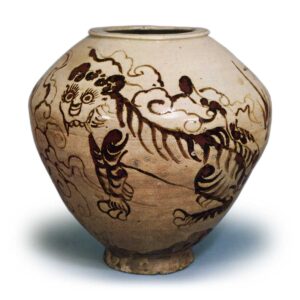
Ceramics from the Yi Dynasty of Korea. The Yi dynasty encompassed the period from the beginning of the Ming dynasty to the end of the Qing dynasty in China and the period from the Northern and Southern Dynasties to the early Meiji period in Japan, and encompassed a history of more than 500 years. It is very difficult to create a lumped concept of all of them. Looking back at the history of the development of ceramics in Japan, the pottery industry finally came into order in Japan 200 years after the founding of the Yi Dynasty, and it goes without saying that much of the influence of the Yi Dynasty’s pottery industry has been transmitted to Japan. As the tea ceremony became popular in Japan, Korean ceramics were in great demand, and a large number of Yi Dynasty ceramics were imported to Japan under the name of “Koryo” (Goryeo) ceramics. The transition of Yi Dynasty ceramics can be divided into the four periods shown on the left. (1) the heyday of Mishima porcelain in the early Yi Dynasty (100 years), (2) the hardhanded white porcelain period of the mid Yi Dynasty (150 years), (3) the heyday of underglaze blue porcelain in the late Yi Dynasty (200 years), and (4) the last period of the Yi Dynasty (50 years).
Early period: Although the Goryeo celadon tradition remained, Mishima-te ceramics were most widely used, and hard-handled white porcelain appeared for the first time. Although Mishima-te has been considered a product of the Goryeo Dynasty, excavation and other studies have shown that the Goryeo inlaid technique was most developed during the Yi Dynasty, and the Mishima-te as we know it today was perfected. In the Jinmu period (mid-19th century), Mishima-te gradually declined, and instead, hard-handled white porcelain reached its peak, and underglaze blue porcelain also saw its beginnings.
Hard white porcelain with a bluish tinge was actively produced during this period, and many shards can be seen at the kiln sites near Seoul. Originally, white porcelain had already been fired in the Goryeo Dynasty, and although in small quantities, the glaze was vitreous, the fire rate was quite high, and the base was transparent, which in Japan is called Goryeo white porcelain (however, the milky white thin porcelain called white Goryeo in Japan is not from Korea but mostly from China). In the Yi Dynasty, however, the hand of Koryo white porcelain became somewhat hard, perhaps due to the ash content. The patterns were painted with iron and cinnabar sands, and the craftsmanship was unparalleled. The Imjin Chongyu Rebellion (1592-1958), however, devastated Joseon and many potters came to Japan, so many artifacts from this period are still in Japan.
The late period was the heyday of blue-and-white porcelain, and hard-handled white porcelain waned a little due to changes in the quality of the wares. The pottery industry did not develop properly and the amount of ceramics produced decreased significantly due to the government’s confiscation of vessels made by artisans without compensation. The pottery industry did not develop in a proper manner, and the quantity of ceramics greatly decreased. The relationship between Japan and this period was much less than in the previous period, and the number of items that came to Japan was not as large as in the previous period.
However, the products of this period are truly remarkable. Originally, under the influence of China, the underglaze blue and white porcelain technique was attempted in the early Yi Dynasty, but it was discontinued for a time, and it was not until the Ming Dynasty (1573-1620) and the Imjin-Chingyu Rebellion that something truly Yi Dynasty-like was produced. The main items produced during this period were jars, utensils, and stationery.
The jars and stationery are unique to this period and are truly admirable. Unlike Mishima and Tessuna, the outward force of this pottery is more inward, giving the impression of a special historical background. In general, the Shikikanin Branch Kiln is the home of somezuke ware, and the use of gosu is very skillful, and the drawings are also very excellent. In particular, they favored the depiction of small birds, fish, and peonies.
The techniques used in the form of carving, such as through-carving, also varied, and the types of stationery, such as brush stands and water droplets, are the most varied. White porcelain other than underglaze blue has a softer, thicker texture than the sharpness of the early period and the hardness of the middle period, giving the viewer a sense of warmth and serenity.
Late period] This refers to the last 50 years of the Yi Dynasty. During this period, the situation in Korea was very eventful both at home and abroad, and the ceramic industry was not as pure as it had been in the first 200 years, but was in decline, and the phenomenon was literally terminal. After the regency of the Dae-won-sun, it became impossible to transport even raw clay to the branch kilns due to expenses, and the kilns had to be temporarily closed. 1895 (Meiji 28), Arita-yaki potters were invited to learn plaster mold making and cobalt usage methods, but the tradition of Yi Dynasty ceramics was lost. (On the Value and Transition of Yi Dynasty Ceramics)



